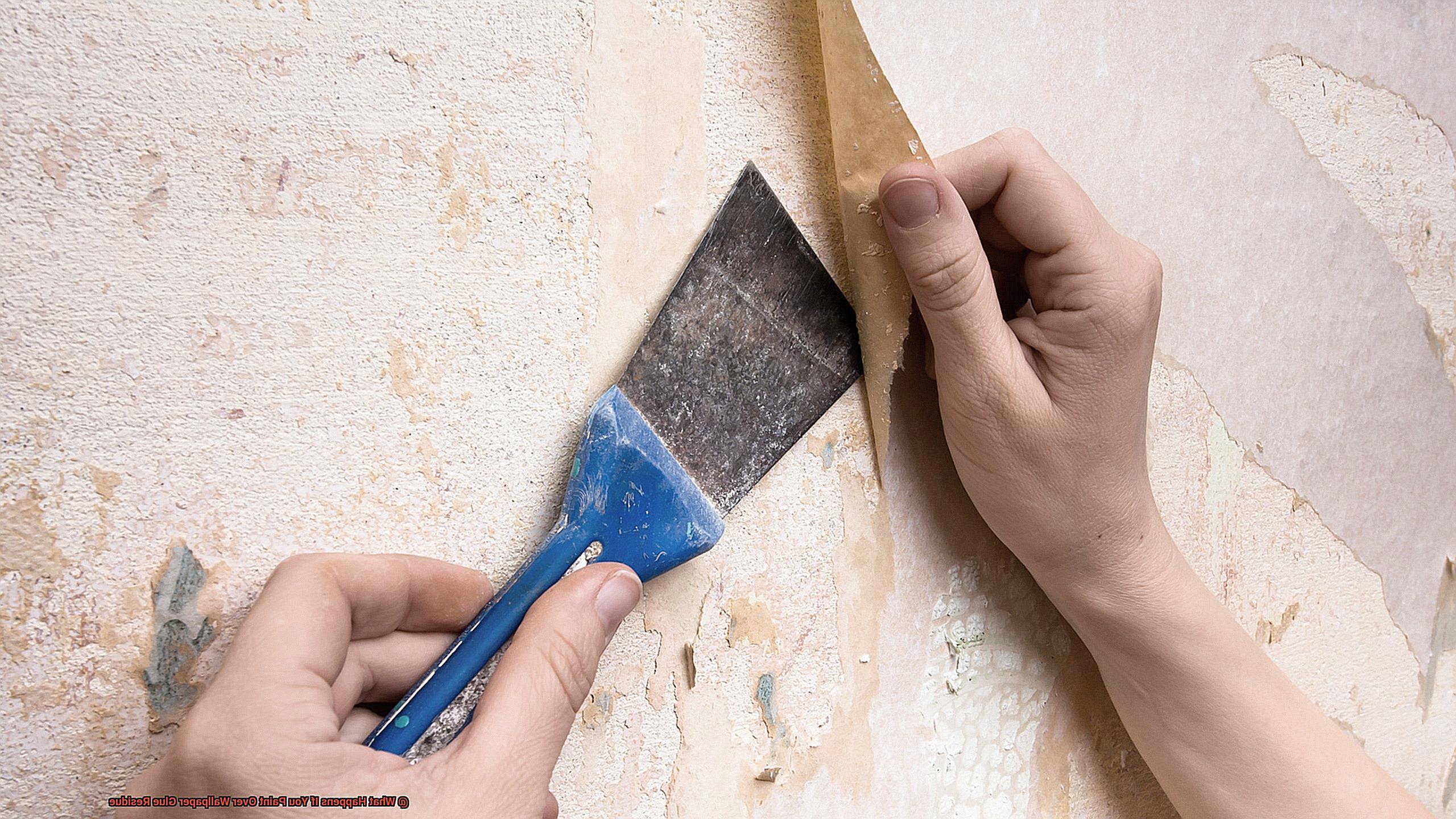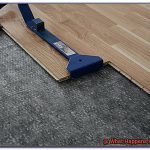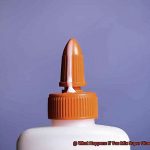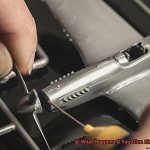Removing wallpaper can be a daunting task, but dealing with the leftover residue of wallpaper glue is an even bigger headache. You might be tempted to skip the removal process and paint over it, but hold your horses. Before you grab that paintbrush, let’s talk about what could happen if you choose to ignore the glue.
Painting over wallpaper glue residue is not as simple as it seems. It may look like a quick fix, but it can lead to a host of issues down the line. For starters, the glue can prevent paint from sticking properly, causing unsightly bubbles and peeling paint. This could result in a frustrating and costly do-over.
So what are your options? Should you attempt to remove the glue or explore alternative solutions? In this blog post, we’ll delve into the potential consequences of painting over wallpaper glue residue and provide some helpful tips for tackling this common problem. From understanding how to prep your walls correctly to exploring other options besides painting, we’ve got you covered.

Don’t let wallpaper glue residue ruin your DIY project. Keep reading to find out how to handle this pesky problem like a pro.
What is Wallpaper Glue Residue?
Contents
- 1 What is Wallpaper Glue Residue?
- 2 What Type of Paint Should You Use?
- 3 Preparing the Surface for Painting
- 4 Advantages of Painting Over Wallpaper Glue Residue
- 5 Disadvantages of Painting Over Wallpaper Glue Residue
- 6 Steps to Take Before Painting Over Wallpaper Glue Residue
- 7 Alternative Solutions for Removing Wallpaper Glue Residues
- 8 Tips and Tricks for Painting Over Wallpaper Glue Residues
- 9 Conclusion
This stubborn leftover adhesive is often sticky, unsightly, and can ruin the appearance of a room. The residue can also be different in color or texture than the rest of the wall, making it stand out even more.
The cause of wallpaper glue residue lies in the moisture of the wallpaper adhesive seeping through the paper and into the wall. Over time, this adhesive hardens and becomes difficult to remove. While some wallpaper adhesives are water-soluble and easily removable with warm water and soap, others require specialized products or tools.
It’s important to note that painting over wallpaper glue residue is not recommended. The residue prevents proper paint adhesion, leading to peeling or flaking over time. Moreover, it may continue to seep through the paint, causing discoloration or bubbling. Therefore, it’s crucial to remove any residue before painting.
Before painting, it’s essential to prepare the surface properly by removing excess glue residue. Sanding down rough spots and applying a primer designed for surfaces with adhesive residue can help. However, if the wallpaper glue residue is particularly stubborn, specialized products or tools may be necessary.
If time permits, it’s best to completely remove both the wallpaper and any residue before painting. While this may seem like a daunting task, it will ultimately result in a smoother and more even surface for your new paint job.
What Type of Paint Should You Use?
You’ve tackled the daunting task of removing wallpaper, but now you’re left with a sticky residue that’s ruining your walls. Fear not, with the right paint and proper techniques, you can transform your walls into a masterpiece. However, it’s crucial to understand what type of paint to use to ensure a flawless and long-lasting finish.
Let’s start with primers. When painting over wallpaper glue residue, a high-quality primer is essential. Not only does it create a smooth surface for your paint to adhere to, but it also seals in any remaining glue residue, preventing it from bleeding through the paint. When selecting a primer, make sure it’s specifically designed for wallpapered surfaces. These types of primers have high adhesion properties and can penetrate any leftover glue residue, ensuring a flawless result.
Now, let’s discuss the type of paint to use. Latex paints are popular among homeowners because they dry quickly and are easy to clean up with soap and water. They’re perfect for those looking for a quick and easy project. However, if you’re seeking a more durable finish, consider using oil-based paints. They’re more resistant to wear and tear and provide a smoother finish than latex paints. They’re ideal for high-traffic areas or rooms with high moisture levels like bathrooms or kitchens.
Lastly, consider the sheen of the paint you choose. Matte or flat paints are excellent for hiding imperfections on walls but may not be as durable as semi-gloss or high-gloss paints. Semi-gloss or high-gloss paints provide a shiny finish that is easy to clean but may highlight any imperfections on your walls.
Preparing the Surface for Painting
If you’re dealing with the pesky residue left behind by old wallpaper, don’t worry. Preparing the surface for painting is an essential step to ensure that your paint adheres well and lasts longer. Here’s a step-by-step guide to help you tackle wallpaper glue residue like a pro.
First, remove any loose wallpaper or debris from the wall to create a smooth surface for painting. Then, use a wallpaper steamer or warm water and scraper to remove as much of the glue residue as possible. This step may take some time, but it’s essential to remove as much residue as possible for proper adhesion of the paint.
Once you’ve removed as much residue as possible, it’s time to wash the walls with warm, soapy water. This will help remove any remaining glue residue and prepare the surface for painting. Rinse the walls with clean water and allow them to dry thoroughly.
If you still see visible traces of glue residue on the walls after washing, don’t fret. You can use a primer specifically designed for sealing porous surfaces like wallpaper glue residue. Applying a primer will prevent the glue from bleeding through the paint and causing discoloration. It will also provide an even surface for painting and improve the durability of your paint job.
Advantages of Painting Over Wallpaper Glue Residue
Painting over it is a practical solution that can save you time, money, and effort. Let’s explore the advantages of this quick and easy fix.
Firstly, painting over wallpaper glue residue creates a smooth and even surface. The paint covers up any bumps, ridges, or imperfections caused by the residue, resulting in a clean and fresh appearance for your walls. Furthermore, it provides a stable base for the new coat of paint, preventing future peeling or cracking.
In addition to creating a flawless finish, painting over wallpaper glue residue also saves time and effort. Removing the residue can be an arduous task that requires a lot of scraping and sanding. This process can damage your walls and take up precious hours of your time. Painting over the residue is a simple solution that can save you valuable labor hours.
Not only does painting over wallpaper glue residue save time, but it also saves money. Removing the residue requires specialized tools and materials such as scrapers, sandpaper, solvents, and cleaners. These items can add up quickly, especially if you need them for multiple rooms in your home. Painting over the residue only requires paint and basic tools like brushes or rollers.
To sum it up, painting over wallpaper glue residue is a practical solution that provides many advantages. It creates a smooth and even surface, prevents future peeling or cracking of paint, saves time and effort, and saves money on costly removal tools and materials.
Disadvantages of Painting Over Wallpaper Glue Residue
While it may appear to be a quick fix, there are several disadvantages you should know about before you start. As an expert on this topic, I have researched and found that painting over wallpaper glue residue can have more drawbacks than benefits.
One of the primary issues with painting over wallpaper glue residue is that the paint may not adhere correctly to the surface, resulting in peeling or bubbling over time. This can create an uneven and unattractive finish, causing you to spend extra time and money fixing it. You don’t want to end up redoing your walls because the first coat didn’t stick correctly.
Another problem is that the paint may not cover the residue entirely, leaving a rough surface that’s especially noticeable with lighter colors or glossier sheens. The glue can seep through the paint, resulting in a bumpy texture that detracts from the smooth finish you desire. Nobody wants a wall that looks like it has bumps all over it.
Additionally, painting over wallpaper glue residue can make a mess. As the paint dries, it can trap and seal in any leftover residue, which can cause further harm to your walls. This makes it more difficult to remove the residue later on if you decide to change your decor. You don’t want to deal with wall damage when you’re trying to switch up your style.
Steps to Take Before Painting Over Wallpaper Glue Residue
Don’t let it deter you from giving your home a fresh new look. As an expert on this topic, I have compiled some research notes to help guide you through the necessary steps to take before painting over wallpaper glue residue.
First and foremost, it’s crucial to remove as much of the glue residue as possible. You can use a scraper or sandpaper, and if that proves difficult, a solution of warm water and vinegar can help soften it up. Once the surface is clean, it’s time for a deep clean with a warm water and mild detergent solution. Rinse it thoroughly and allow it to dry completely before moving forward.
Now that the surface is clean, applying a coat of primer may be necessary before painting. This helps seal any remaining glue residue and creates a smooth surface for the paint to adhere to. Choose a primer specifically designed for use on wallpaper glue residue for optimal results.
When selecting paint, opt for high-quality paint that is designed for difficult surfaces. This ensures proper adhesion and results in a long-lasting finish. Depending on the condition of the surface and type of paint being used, multiple coats may be necessary.
Alternative Solutions for Removing Wallpaper Glue Residues
There are several alternative solutions that can assist you in removing them without breaking a sweat.
One of the most common methods is using a wallpaper removal solution or stripper. These products are specifically designed to dissolve wallpaper glue and make it easier to scrape off with a putty knife or scraper. Alternatively, you can mix equal parts of hot water and fabric softener in a spray bottle and spray it onto the residue. Allow it to sit for a few minutes before scraping it off.
Vinegar is another popular alternative solution for removing wallpaper glue residues. Mix equal parts of vinegar and hot water in a spray bottle and apply the solution onto the residue. Leave it for several minutes before scraping it off with a scraper or putty knife.
If these solutions don’t work, you can try sanding the walls with sandpaper or using a heat gun to soften the glue before scraping it off. However, be cautious while using these methods to avoid damaging the walls or creating a fire hazard.
Tips and Tricks for Painting Over Wallpaper Glue Residues
If you’re looking to paint over old wallpaper but concerned about the glue residue left behind, don’t fret. There are several tips and tricks that can help ensure a successful paint job.
Thoroughly clean the surface
The first step is to remove any remaining wallpaper and loose glue residue using warm soapy water and a scraper or sponge. It’s crucial to let the surface dry completely before moving on to the next step.
Use a high-quality primer
Applying a primer is necessary to create a smooth surface for the paint to adhere to. It’s important to choose a primer that is specifically designed for porous surfaces like wallpaper glue residues. This will help seal any remaining residue and prevent any potential issues like peeling or cracking.
Pick the right type of paint
When it comes to choosing the paint, oil-based paints are generally more effective at covering up wallpaper glue residues, but they can have a strong odor and take longer to dry. Water-based paints are more popular as they dry quickly and are low odor, but may require multiple coats for full coverage.
Consider using textured paint or wallpaper
If you’re still worried about any remaining imperfections, consider using textured paint or wallpaper. Not only can this create an interesting visual effect, but it can also provide a solution for any remaining issues on the surface.
Be patient
Painting over wallpaper glue residues requires patience and proper preparation. Rushing the process could lead to an uneven finish or peeling paint. Take your time to properly clean and prime the surface before proceeding with painting.
9iyji43LbtM” >
Conclusion
In conclusion, while it may be tempting to take a shortcut and paint over wallpaper glue residue, it’s important to remember that this can lead to a myriad of issues in the long run. The glue can create unsightly bubbles and peeling paint, making your efforts go to waste. Therefore, it’s imperative to remove any residue before painting.
To ensure a properly prepared surface, start by sanding down rough spots and applying a primer specifically designed for surfaces with adhesive residue. When selecting your paint, opt for high-quality options that are formulated for difficult surfaces. Applying multiple coats may also be necessary for optimal results.
While painting over wallpaper glue residue has its advantages such as saving time and money on removal tools and materials, it also has its disadvantages such as potential peeling or bubbling of paint over time and leaving behind an uneven surface that is especially noticeable with lighter colors or glossier sheens.
Fortunately, there are alternative solutions available for removing wallpaper glue residues such as using wallpaper removal solution or stripper, fabric softener solution, vinegar solution, sandpaper or heat gun.
In summary, taking the extra steps to remove wallpaper glue residue before painting will result in a smoother and more even surface for your new paint job.






